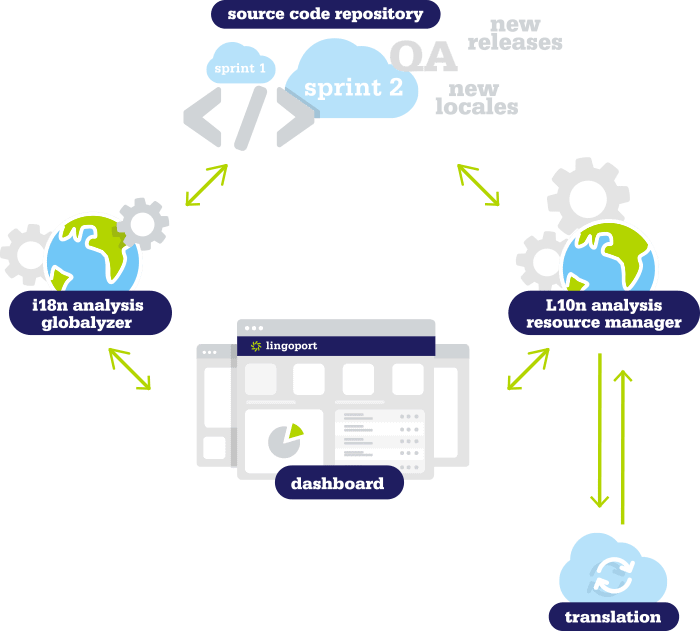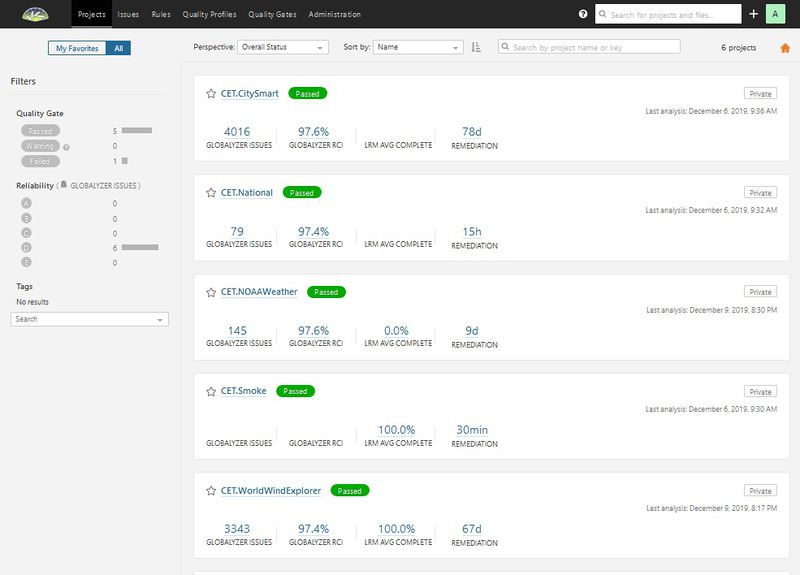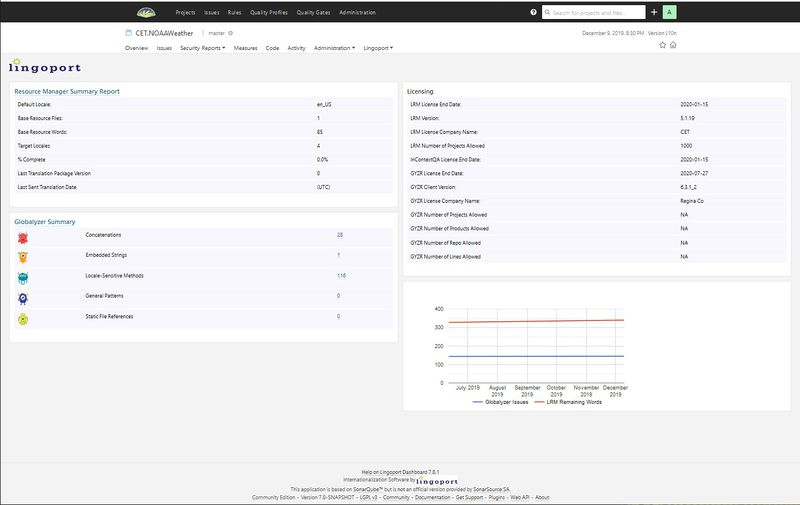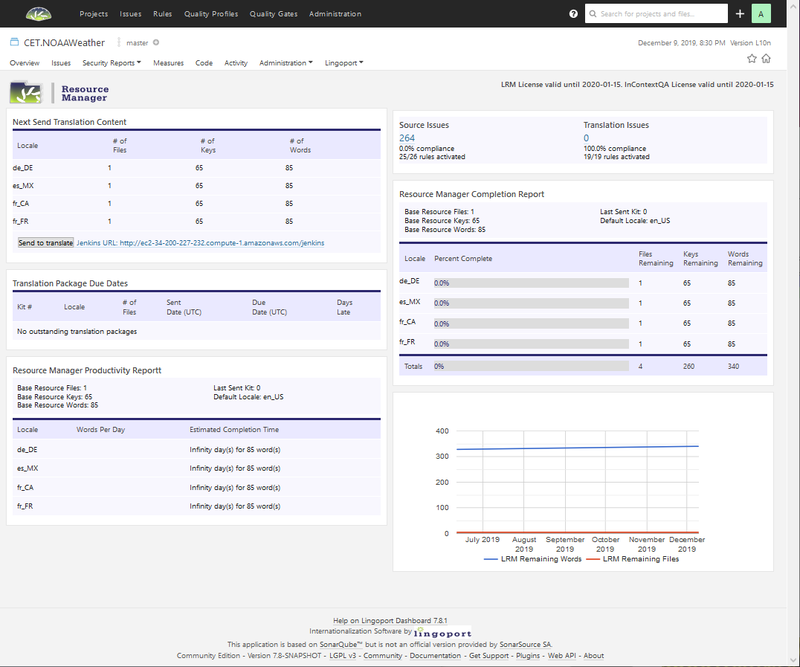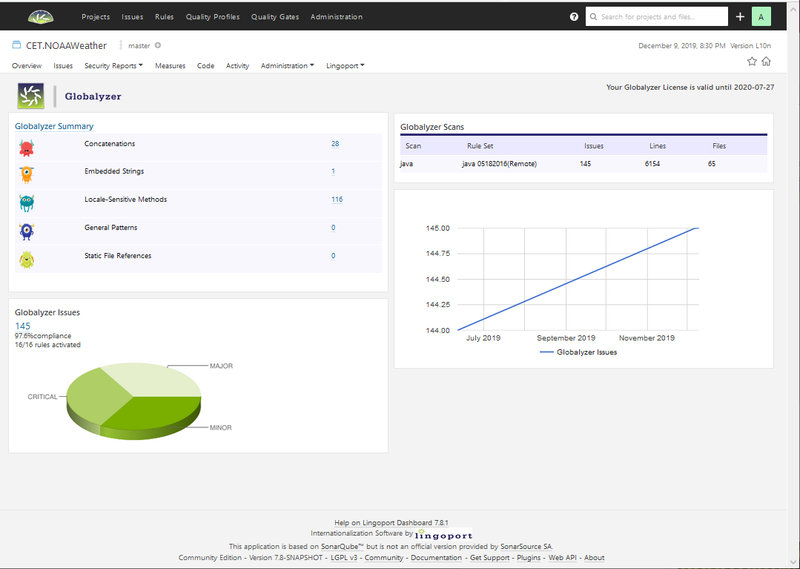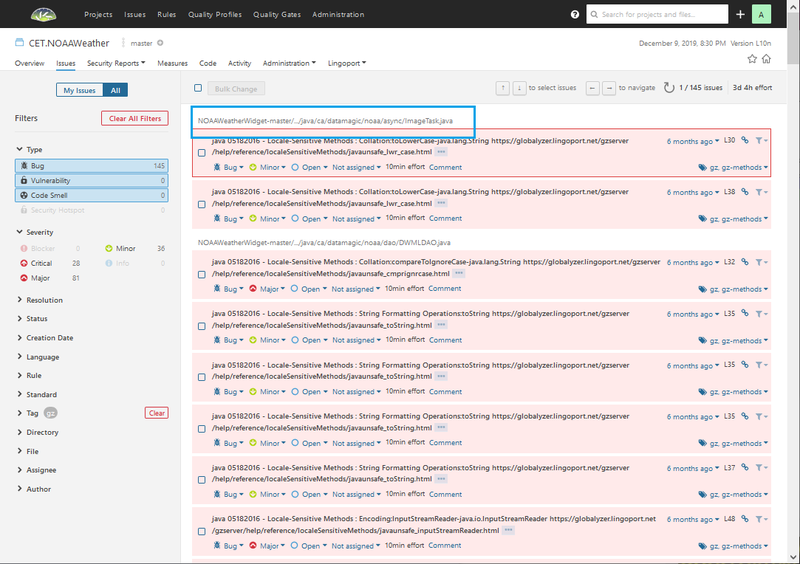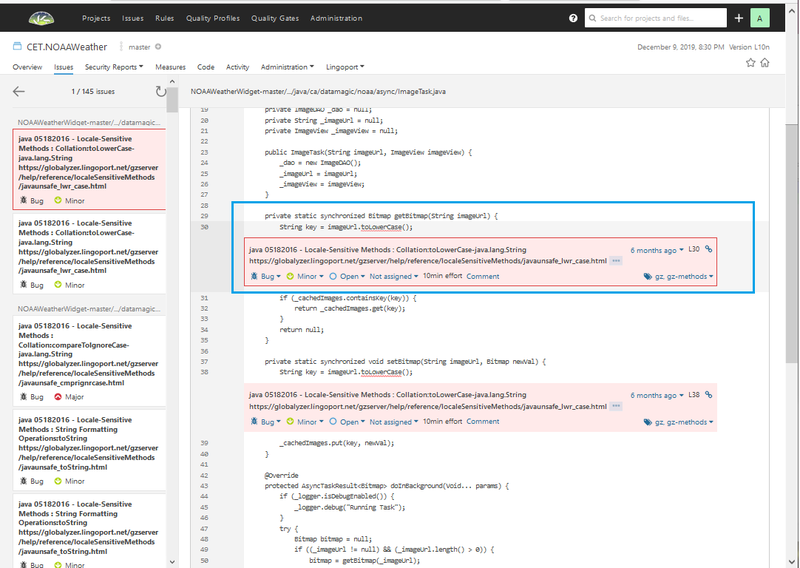Introduction
Contents
Lingoport - Overview
Lingoport provides products and services which help our clients continuously meet internationalization and ongoing localization challenges relating to software development and active globalization.
The Lingoport Products help software engineering teams with the globalization tasks:
- Automatically find and manage internationalization issues and localization changes in your source code and repositories for a wide variety of programming languages.
- Integrate with translation management systems and localization vendors for rapid globalization development, testing and deployment.
- Verify translations in an efficient, process-driven manner.
- Works behind your firewall keeping your source code secure.
Contact Information:
Phone: +1 303-444-8020
Email: info at Lingoport.com
Lingoport, Inc.
Services
Lingoport has been providing software internationalization (i18n) consulting services since the company's inception in 2001.
These services include:
- I18n Analysis - plan for new i18n projects, or gap analysis for mitigating i18n issues. A Lingoport architect and supporting team members clarify i18n business, technical and resource requirements based on market requirements, development discussions, programming technologies and Globalyzer scanning results.
- I18n Implementation - Lingoport provides i18n development teams that can work in a hybrid approach, collaborating with client teams, as well as in turnkey fashion.
- General i18n Consulting and Custom Projects - Sometimes specific problem solving or i18n bug fixing is needed. Lingoport can fulfill that resource need, working in coordination with your teams.
- Process Customization - Any Lingoport product purchase includes consulting time to customize and optimize the Lingoport product suite for the customer.
Lingoport Products
The Lingoport Suite supports the continuous globalization process, from the code repository to the translation vendors and back.
Globalyzer – Supports individuals and entire development teams in finding, fixing and maintaining internationalization issues in code in a broad list of programming languages. (More information at Lingoport.com/Globalyzer).
Localyzer – Provides simplified resource file management, verification and translation updating. Localyzer helps development and localization teams keep up with initial and ongoing application interface resources, their translation and automated re-insertion into product builds. (More information at Lingoport.com/LRM).
- Machine Translation - Lingoport Supports several popular machine translation vendors as part of the continuous globalization and localization process.
LocalyzerQA - A simplified way to perform linguistic review and verify and correct translation issues as part of the continuous globalization process.
Express Suite
- Globalyzer i18n Express- Globalyzer i18n Express is a GitHub application which scans the added and modified files checked in on a GitHub commit, looking for i18n issues. The committed files are scanned with default rule sets. Files checked in will be scanned and a summary will be added as a comment to the commit in GitHub.
- Localyzer Express - Localyzer Express is a GitHub application which allows for a near immediate translation of standard application resource files. Resource files are used by internationalized applications to display user facing strings (such as user interface labels) in different locales (languages, country, variant). As an example, messages.properties, an English resource file, can be translated in French and Japanese, respectively messages_fr.properties and messages_ja.properties.
Additional Specialized Applications
In addition to the product suite, Lingport has several integrated components to create and maintain software for any language or cultural format in every release increment :
- Dashboard: The hub of our suite. See it all, drill down, create notifications and manage the process. Bridge gaps between localization & development. Increase visibility and track globalization metrics.
- Jenkins: Onboard projects for globalization and translation management that can be monitored on the dashboard.
- IDE (Integrated Developement Enviroment) Integration: Developers can identify and fix globalization and localization issues in real time.
- LingoBot : Slack and MS Teams system integration
Together with the products and assorted specialized applications, Lingoport enables continuous tracking and updates to the internationalization and localization status of software products.
An Example of the Continuous Globalization Process
- first, start with the code repository. - Jenkins sets up the job to check the code out of the repository. The jenkins job sets up the locales to translate to, resource file type and the translation vendor that will be used. It also creates special files for pseudo localization and for use in LocalyzerQA. - Running a jenkins job does the Globalyzer analysis that can be checked on the dashboard. It also identifies the resources files and what needs to be sent to be translated. If a translation vendor is machine translation, then the Jenkins job automatically does the translation, and pushes the files to the code repository. - For traditional localization vendors, the dashboard has a button to send the identified files to the vendor for translation. Jenkins will also automatically check for returned files, import them and pushes the files back to the repository. - During the Linguistic Review process, LingoportQA uses a special resource file with identifier keys that can be used to indicate which terms need to be corrected. LingoportQA submits the changes and if there is machine translation, the code is fixed and the new strings is pushed to the repo. For traditional translation vendors, an additional approval step is done, the files are imported and pushed to the repo.
The Lingoport Dashboard
- Displays the overview and details of Globalyzer scans and the Resource Manager translation status
- Users may view Globalyzer and Resource Manager issues in context within the source code.
- Runs on the Continuous Globalization System
Here is an example of the Lingoport Dashboard. This is the Dashboard Home page which shows several Lingoport Projects defined. For the project CET.NOAAWeather, there are 145 Globalyzer Issues, it is 97.6% complete. The project uses Localyzer and is 0.0% translated.
If CET.NOAAWeather is selected, we open a more detailed overview of the Lingoport Suite functions.
Lingoport Overview
This page shows the summary of the Globalyzer Scan and the Localyzer status.
This shows that the Globalyzer Scan identified 28 Concatenations, 1 Embedded String and 116 Locale-Sensitive Methods. Selecting Globalyzer Summary goes to the Globalyzer page with more details about the scans.
Localyzer shows 1 Base Resource File to be translated into 4 Target Locales and it is 0% Complete. Selecting Resource Manager Summary Report goes to the Resource Manager page with more details about about translation.
The licensing dates are prominently shown and the number of Globalyzer and Resource Manager issues.
In the top right of the window, the date shown is the last time the Dashboard was updated.
Localyzer
Localyzer manages resource files as they are sent to and returned from the translation management system.
- Detects issues in resource files (duplicate or missing keys, parameter mismatch in text for different languages, etc.)
- Detects changes to base resource files. Then sends relevant changes out to the translation vendor for translation into other languages.
- Automatically retrieves translations from translation vendors and checks those changes into the source control repository.
- Runs on Continous Globalization System to populate the Lingoport Dashboard.
This screen shows the details for the Localyzer status for project CET.NOAAWeather.
Notice the Localyzer Completion Report on the right side. This shows the 4 locales and each of them are 0% translated. There is 1 file with 65 keys and 85 words that need to be translated for each locale.
In the Next Send Translation Content, there is 1 new file to send to translation for each locale.
In Translation Package Due Dates, there are no outstanding translation packages. If any translations were out they would show up here with their due dates.
Globalyzer
Scans code and detects internationalization (i18n) issues
- Connects to the Globalyzer server and logs in. (This might not happen if local rule sets are used)
- Downloads rule sets from server, or uses local rulesets.
- Uses rule set to scan code.
- Displays the i18n issues.
- Can run on developer machines in an Integrated Development Environment
- Runs on the Continuous Globalization System - these results are displayed on Lingoport Dashboard
The Globalyzer screen shows more of the details of the Globalyzer Scans. For this example, looking at the Globalyzer Scans at the right side of the screen, we see that only one scan was done. It was a scan named java based on the Rule Set named java05182016 which found 145 issues in 6154 lines and 65 files. The rule set is shown as Remote which indicates that it was found on the Globalyzer Server. The alternative is a local rule and no connection to the server.
Under Globalyzer Summary, the types of issues are shown. To see these in more detail, select the number and the issues page will open.
These issues are identified as Major, Critical or Minor in the Globalyzer Issues pie chart.
If 145 is selected under Globalyzer Issues, more detail of the identified issues can be seen.
Issues
The Issues page shows all the selected issues. In this case, it is showing 145 issues.
For the issue at the top of the screen, the file ImageTask.java has a Locale Sensitive Method issue with the use of the java.lang.String method toLowerCase. Selecting the file will show the issue in the code.
Lingoport Product Details
Globalyzer
Lingoport's Globalyzer scans source code for internationalization issues. It uses sets of regular expression based rules ('rule sets') on tokens found by lexers/parsers to detect these issues and to filter false positives. These rule sets are synced and stored on a single server, and may be downloaded onto numerous client applications which perform the source code scans. Please note that the rule sets are only lists of regular expressions, and do not contain any code.
Client applications include an IDE tool ("Globalyzer in IDE"), a desktop client ("Globalyzer Workbench"), command line clients ("Globalyzer CLI" and "Globalyzer Lite"), and an API that may be used to construct custom programs including Globalyzer code scanning functionality. Client applications may produce scan results in XML, CSV, HTML and Excel formats. Results are also consumed by the Lingoport Dashboard to be analyzed and displayed. The desktop client may also be used to view the results directly. It may be used to scan files that developers are working on, and will display the scan results in the IDEs console output window.
Globalyzer Server - allows development teams around the world to share and collaborate together using high powered internationalization rule sets during scanning of code. Development Teams can set up their own server, or use Lingoport's Globalyzer Server to set up users and rule sets.
Globalyzer Clients
- Globalyzer Lite in IDE - It is ideal for scanning code for internationalization issues on the fly and generating corresponding reports. It does not require an external database. Globalyzer Lite parses and executes Globalyzer Lite Project Definition XML files. Globalyzer Lite in IDE can be incorporated into developers' IDE platforms for a true continuous improvement and development system.
- Globalyzer Workbench - provides a fully functional code analysis and editing environment for finding, fixing, testing and reporting on internationalization issues in a wide variety of programming languages. Globalyzer Workbench runs as a stand-alone desktop editor in an Eclipse Environment.
- Creates the Project Definition XML files.
- Sets up the Machine Learning environment.
- Updates Rule Sets on the server and exports them to the local clients.
- Creates the resource files to be used by Localyzer .
- Globalyzer Command Line - create automated Globalyzer scans as part of your continuous integration so that you can report and track internationalization issues over time. There is also a Globalyzer Ant Client, Maven Client and XSL Client.
- Globalyzer API - allows you to create Globalyzer projects and scans, execute scans, and generate reports from a Java program.
Localyzer (formerly LRM)
Localyzer manages resource files, which contain application text as key-value pairs (the keys are used in the application to retrieve the associated text). Resource files are typically translated across languages as part of the localization process. Localyzer is used to determine the translation status of these resource files using a MySQL database. It also automates the process of sending text out to translation vendors when changes are made to be base (usually English) application text. Localyzer is often used in Jenkins scripts to automate translation.
Localyzer also performs various checks regarding the resource files. These checks include confirmation of file integrity, detection of duplicate or missing keys, and numerous other validations. When a translation vendor returns translated text for these resource files, Localyzer will detect the new content and perform its validations. If the validations pass then Localyzer will merge the new translations into appropriate resource files and check these in to source control. The check-in is typically done on a dedicated localization branch.
InContext Translation
Used by translators, resource files are instrumented as they are sent to translation management systems so that they can see the string in the application and its context in order to translate more effectively.
InContext QA
The translation reviewer can easily select instrumented resources in an application, identify poor translations, and give suggestions for making improvements. InContext QA greatly improves the translation quality assurance process and can be a vital part of the continuous improvement environment.
Lingoport Dashboard
The Lingoport Dashboard displays the internationalization and localization status of software projects. The Lingoport Dashboard scans source code and reads in XML reports generated by Globalyzer and Localyzer. It then sends the information to the web server built on the SonarQube platform and displays the information in an easy to digest fashion. This information includes all detected internationalization issues, which may be viewed in source code - with the affected line(s) highlighted. The translation status, translation history, and current translation efforts for projects are also displayed.
Stack Installer and Stack Updater
The Lingoport Stack Installer and the Stack Updater are automated tools to install, or update, and configure the Continuous Globalization System and the Lingoport Dashboard Server and Client. They install and configure prerequisite software programs and then install, or update, LRM, Globalyzer client, and Lingoport Dashboard.
Jenkins (not a Lingoport program)
- Web application used to automate running of Globalyzer Client, Resource Manager and updating of the Lingoport Dashboard
- Various security options available, username/password is most common. LDAP is another option.
- Run on Linux system
